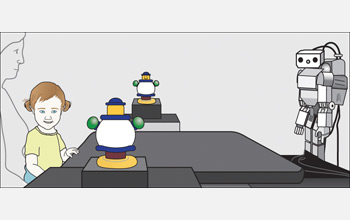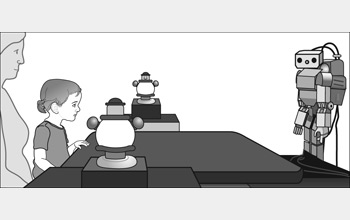All Images
Research News
Babies Learn From Robots While Robots Learn From Babies

In an University of Washington experiment involving 64 toddlers and a metallic robot, babies who had watched the robot play games with a researcher followed the robot's "gaze." The toddlers wanted to see what the robot was seeing.
Credit: Reprinted from Neural Networks, Volume 23, Issues 8-9, October-November 2010, pages 966-972; "Social" robots are psychological agents for infants: A test of gaze following; Andrew N. Meltzoff, Rechele Brooks, Aaron P. Shon and Rajesh P.N. Rao; Figure 5; © 2010, with permission from Elsevier.
Others wishing to use this image please contact "Neural Networks."
Download the high-resolution JPG version of the image. (237 KB)
Use your mouse to right-click (Mac users may need to Ctrl-click) the link above and choose the option that will save the file or target to your computer.
University of Washington computer scientists programmed a metal robot named Morphy with human-like movements to see if 18-month-olds would interact with it. Researchers say companion robots like Morphy will need to interact in fundamentally human ways to be accepted by humans. This video provides a good illustration of the robot's dexterity as it follows and kicks a ball.
Credit: Rawichote Chalodhorn, University of Washington

A team of scientists from the University of Washington co-led by psychologist Andrew Meltzoff and computer scientist Rajesh Rao recently determined that it is not only what something looks like, but how it moves and interacts with others that gives even inanimate objects social significance.
Credit: Mary Levin, University of Washington
Download the high-resolution JPG version of the image. (2.3 MB)
Use your mouse to right-click (Mac users may need to Ctrl-click) the link above and choose the option that will save the file or target to your computer.

Morphy looks at a toy while researchers measure whether an 18-month-old baby will follow the robot's gaze.
The University of Washington's infant-robotics team programmed a metal robot named Morphy to copy some basic human social skills. Then, in an experiment, researchers measured whether 18-month-old babies would interact with and take cues from the robot as if it was a sentient being. When the robot looked at a toy in the room, 13 out of 16 babies, who had watched the robot play with a researcher who also was part of the experiment, followed the robot's gaze as compared to a control group in which babies did not see Morphy interact with the researcher. Only 3 of 16 of these babies turned to where the robot was looking.
Credit: Reprinted from Neural Networks, Volume 23, Issues 8-9, October-November 2010, pages 966-972; "Social" robots are psychological agents for infants: A test of gaze following; Andrew N. Meltzoff, Rechele Brooks, Aaron P. Shon and Rajesh P.N. Rao; Figure 5; © 2010, with permission from Elsevier.
Others wishing to use this image please contact "Neural Networks."
Download the high-resolution JPG version of the image. (105 KB)
Use your mouse to right-click (Mac users may need to Ctrl-click) the link above and choose the option that will save the file or target to your computer.
